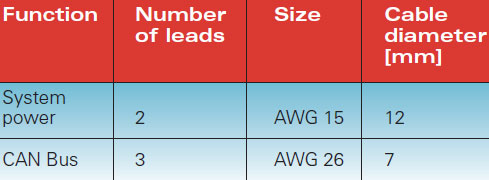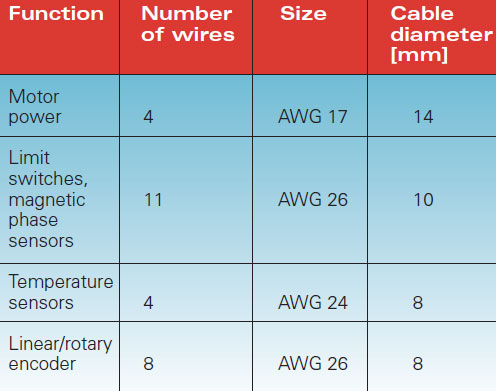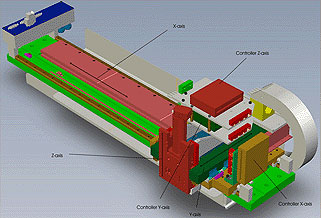by Alexander Bromme, Managing Director, Steinmeyer FMD and George Jaffe, Executive VP, Steinmeyer Inc.
The use of new, miniature single axis motion controllers enables an innovative cabling concept. Each axis carries its own peripheral controller connected with motor, encoder and sensors by means of short, stationary cables. The peripheral controllers are connected by a high throughput data bus system that allows interpolated movements between different axes. Thus, the number of moving cables (one power, one data bus) is independent of the number of axes in a system.
Cable reduction can be especially useful in wafer inspection systems, which typically consist of a stack of XYZ linear stages plus a theta rotary unit. There can easily be 16 connectors at the final electrical terminal with over 100 wires, many of which are in constant motion during system operation. The disadvantages and potential problems of this many cables include:
1. All moving cables must be accelerated, moved, and bent by the stage system itself, which raises driving force, causing an undesirable temperature rise.
2. The bend resistance of the cables is not constant. The result is stick-slip plus randomly distributed effects that complicate precision positioning.
3. Moving cables generate particles and tend to outgas, which is undesirable in clean room applications.
4. Stage system reliability is reduced in proportion to the number of moving electrical lines. The higher the number of moving cables the higher the risk of a failure or defect.
5. Electromagnetic interference between cables may cause crosstalk, creating problems in system integration.
6. A multi-axis moving cable system requires additional space, so the motion system becomes larger to accommodate the many cable carriers. With the extra carriers, total system cost
increases.
A better solution is to reduce the number of moving cables!
How? Replace central multi-axis motion controllers with single separate control modules mounted directly to the axes.
These modules, connected by a high-speed bus interface, even allow interpolated movements between different stages.
In the system developed by Steinmeyer, the bus-interface is Controller Area Network (CAN).
As an example, the model DAC1005 (manufactured by LPKF) is a universal motor controller for one axis. It complies with the CANopen standards (DS 301 and DSP 402) and is certified by the CAN in Automation e. V. It can control DC-, 2- and 3-phase servo-, stepper- and linear motors. Powerful algorithms and high sampling rates guarantee high quality control. The interfaces for limit switches, digital and analog inputs and outputs, and encoders are integrated. Alternatively to CANopen, the communication with a master computer may be executed via a serial port (RS232).
By miniaturizing the electronic PCBs, the size and mass of the individual control boxes is smaller than a comparable cabling system. For a 3-axis XYZ system, instead of a huge number of moving wires, there are three moving control modules, a tiny three wire shielded CAN-bus cable in a daisy chain configuration and two wires for power.

In total, the complete system needs just two separate cables with diameters of 7 mm and 12 mm independent of how many axes the stage system includes. The five electrical leads are easy to handle in one moving cable carrier.
Each axis carries its own motion controller independently. All leads to motor, sensors, and encoder systems have a length of typically less than 20 cm. More important, all the electrical connections to the upper axes are static, which means there is no bending or relative movement of the cables.

With a single linear motor driven stage, each axis can require up to 4 separate cables with diameters of 8 to 14 mm. That means up to 27 electrical wires must be connected. But, replacing a central multi-axis motion controller with single separate control modules mounted directly to the axes can significantly reduce the number of cables in the system.
By shortening the cable length, the main concerns of crosstalk and radiation are eliminated. Instead of a bulky central motion controller, only an external power supply is needed which is usually available in the machine anyway.

The use of separate control modules is an innovative way to reduce the number of cables in a system.
And in case axis replacement is necessary, the complete stage-controller combination is exchanged. So individual stage related information, like PID-controller tuning, is hardware-connected to the mechanical structure. These parameters can be made as a factory setting so the system integrator saves time and money.
Such a configuration was exactly what Scienion AG, located in Berlin, Germany, was searching for its line of ultra-low volume liquid handling systems used in such applications as DNA microarrays, protein microarrays, reversed phase protein microarrays, cell transfection arrays, and Glycan microarrays.
The company’s leading product is the sciFLEXARRAYER, a state-of-the-art non-contact dispensing system for ultra-low volume liquid handling.
The company recently introduced a novel high throughput instrument for array and biosensor production, the model S100 – which includes 3-axis motion platforms designed and manufactured by Steinmeyer FMD.
Steinmeyer Inc.
www.steinmeyer.com


Leave a Reply
You must be logged in to post a comment.